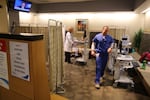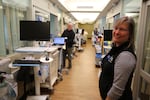It was just another Tuesday at work for nurse Monica Schulz, and the stakes couldn’t have been higher.
“We've got a lot of sad situations going on right now, with a lot of people leaving this world to another world,” said the intensive care unit manager in Bend, her voice breaking: “We’re working really hard with those families to get them comfort and help that be a very peaceful transition.”
Lately, Schulz's difficult ICU job has been even harder because of crowding in the hospital, which serves not just Bend’s population, but a vast sweep of rural Oregon. St. Charles has the state’s only high level trauma center east of the Cascades.

Emergency room staff use the waiting room to see patients and shrink wait times at St. Charles hospital in Bend, March 19, 2019.
Emily Cureton / OPB
Shulz led the way down a cramped hallway connecting rooms where the sickest and most injured people get care. She said the unit has been “at capacity every single day. It's one patient in, one patient out, and it's just really exhausting.”
The work is so demanding, nurses attend to just one or two people in a shift, trying to stabilize them. Once they're treated, there’s pressure to move them out as soon as possible. “And so, it's just a real stress,” Schulz said, “because are they really ready to go … or, are we trying to move them out so we can get a sicker patient in?”
She said transferring people to another hospital isn’t an option a lot of the time: “There's nobody right now in the state or even in the Northwest that has bed capacity, and we check that daily.”
This weekend, St. Charles opens a new wing to address the crowding issue. The expansion increases overall bed capacity by 33, and replaces the cluttered, aging ICU with an upgraded, expansive facility located inside a three-story structure on the Bend hospital campus. The tower promises to solve a host of problems for ICU providers, and ease tensions that have a ripple effect on the entire hospital system.

Intensive care nurse and manager Monica Shulz points out problems with the old facility, two months before the new ICU was set to open, March 19, 2019.
Emily Cureton / OPB
Population growth in Central Oregon is one stressor on the ICU. But hospital staff said gaps in primary care also contribute to more people in crisis, needing hospitalization by the time they get medical attention.
Patients surveyed on social media before the tower opened described frustratingly long waits at St. Charles, as providers face the tough decisions to attend to the most severe cases first. Overwhelmed by flu-related admissions this year, the hospital cancelled elective surgeries for two days in March.
That freed up staff, but also meant 78 people who prepared for an operation found out last minute it wasn’t going to happen. Meanwhile, the most acute patients, those who need to stay in the hospital for specialized care, ended up occupying beds in the emergency department, and that can be lethal, said ED Director Dr. Gillian Salton.
"What it really boils down to is you have higher mortality in your patients. Your patients die more often," Salton said, pointing to studies about the negative outcomes associated with boarding patients in an emergency department, instead of an area of the hospital designed for longer stays.
Last year, ballooning wait times from the backlog prompted emergency providers to use unconventional methods. They started giving people the option of being seen in the waiting room, which brought the average wait time down. By March, it was about half an hour, according to Salton.
Visual privacy is minimal as providers work with patients behind folding screens in the waiting area, so it’s hard for nurses and doctors to do a proper physical exam.
“That’s not ideal care for the patients,” Salton said, but it has reduced the number of people sitting for long periods, or worse, leaving without being seen by a nurse or doctor at all.
That’s how it went recently for Renae Yell of Bend, and her 10-month old baby, Jackson. He got the flu in March. Late one night, he started burning up. Yell remembers the thermometer read 102.9.
“I took him in back into the ER and I got nothing. I just sat, and sat, and sat, and sat, until finally I left,” Yell said.
She recalled waiting about 3 hours before the fear got to her. Was she actually hurting her baby, she wondered, by exposing his immune system to a crowded waiting room full of sick people?
“I have a son that has passed away, in the past,” she said. “As a mother, going into the emergency room and feeling helpless for her child, who’s less than a year old, and then just having that wait … I really felt like I didn't have any other choice but to leave.”
Yell described feeling safer at home, and said they got in to see a pediatrician the next morning. Jackson was healthy again in time for his first birthday in May. But, like him, 3-4 % of people who went to the emergency room in March left without seeing a nurse or doctor, according to Salton.
“I know that, and it pains me,” Salton said as she reviewed department statistics.
Salton is hopeful St. Charles’ new critical care tower will help the emergency room bring the number of people who leave without care down to zero, but she’s not expecting a magic pill.
“I think we need to continue working on the concept of flow as separate from capacity,” she said.

Selena Smith, critical care director for Bend and Redmond hospitals, smiles as plans for a new intensive care unit near completion, March 19, 2019.
Emily Cureton / OPB
Capacity, Salton explained, means space for patients, and flow is a bigger issue that goes beyond the walls of a new building. It’s about how people move through the broader health care system, and how barriers elsewhere can choke circulation at Bend’s hospital.
“I see patients every day who come in because they couldn't get into their doctor, or the first appointment they could get was three weeks from now,” Salton said.
Meanwhile, the wait is over for an expansion to directly serve the most ill and injured people in Central Oregon. The new tower also promises fewer mothers waiting for a sick child to be seen by a doctor, fewer ICU nurses wondering if they made the right call to move a patient, and more support for those we rely on in a crisis.
